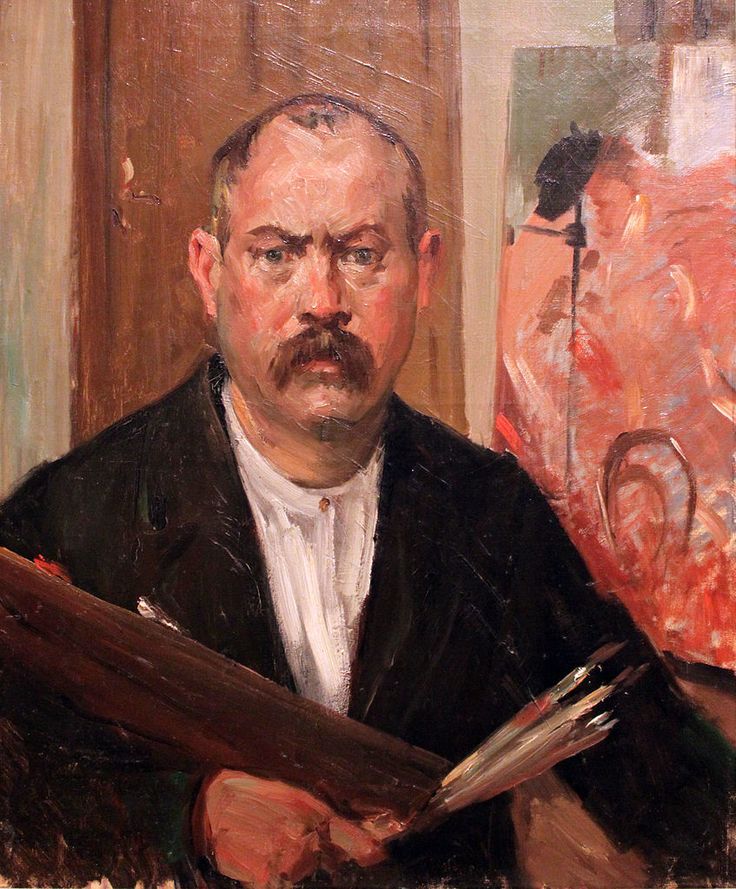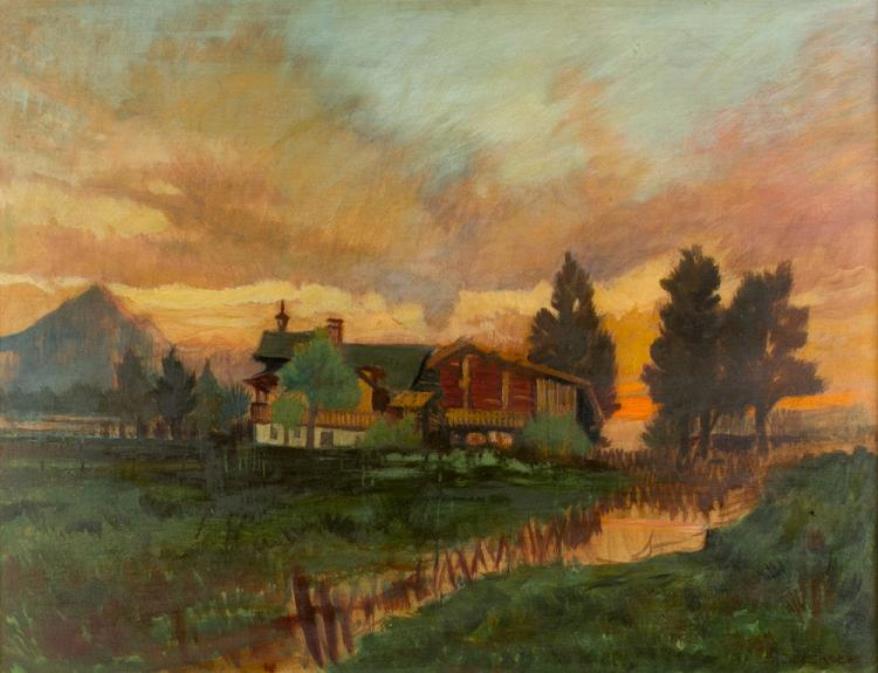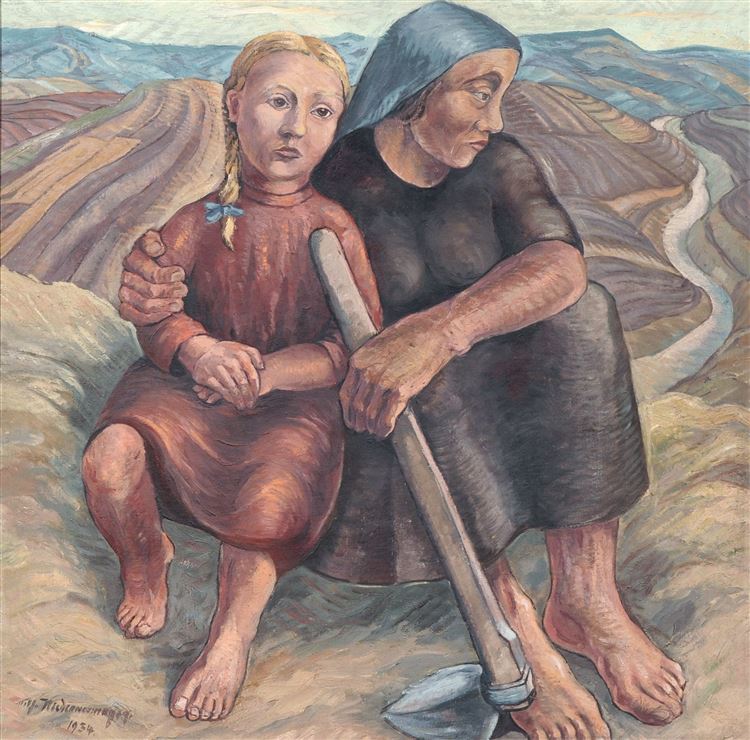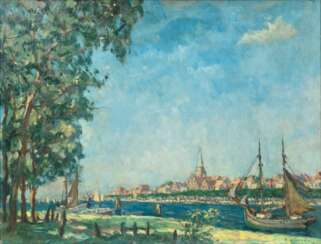helm der k. u. k

Lovis Corinth was a German artist and writer whose mature work as a painter and printmaker realized a synthesis of impressionism and expressionism.
Corinth studied in Paris and Munich, joined the Berlin Secession group, later succeeding Max Liebermann as the group's president. His early work was naturalistic in approach. Corinth was initially antagonistic towards the expressionist movement, but after a stroke in 1911 his style loosened and took on many expressionistic qualities. His use of color became more vibrant, and he created portraits and landscapes of extraordinary vitality and power. Corinth's subject matter also included nudes and biblical scenes.




August Robert Ludwig Macke was an eminent German expressionist painter, founder and member of the Blue Rider association. His very colorful and individual style is today referred to as the Macke style, characterized by a harmonious combination of colors and the play of light effects. His favorite subjects of his works were sketches from the life of the city, as well as nature and man. The paintings of August Macke give an impression of joy and lightness.


Wilhelm Hasemann was a German genre painter and illustrator.


Wilhelm Kaufmann is an Austrian artist who has been called the master of the moment.
He studied at the Imperial Royal Academy of Fine Arts, then worked as a painter and track and field athlete at the same time. Kaufmann used color dynamics to masterfully depict momentary scenes of athletes' movements during competitions. He also painted colorful still lifes, landscapes and portraits.
Wilhelm Kaufmann was a member of the Professional Association of Austrian Visual Artists, the Sonderbund of Austrian Artists, the Vienna Art Association and the Vienna Hagenbund, the Vienna Secession and the Vienna Society of Artists, Künstlerhaus.


Ernst Wilhelm Nay was a German painter and graphic designer of classical modernism. He is considered one of the most important painters of German post-war art.








Paul Wunderlich was a German painter, sculptor and graphic artist. He designed Surrealist paintings and erotic sculptures. He often created paintings which referred to mythological legends.


Wilhelm von Kobell was a German painter of the first half of the 19th century. He is known as a landscape painter, animalist and battle painter.
Von Kobell initially produced landscapes and animal paintings, but later focused mainly on battle painting. He visited Vienna and Paris between 1809 and 1810 to study this genre. His battle paintings, based on extensive research, are characterized by striking realism. They are important for the study of military history.


Wilhelm von Kobell was a German painter of the first half of the 19th century. He is known as a landscape painter, animalist and battle painter.
Von Kobell initially produced landscapes and animal paintings, but later focused mainly on battle painting. He visited Vienna and Paris between 1809 and 1810 to study this genre. His battle paintings, based on extensive research, are characterized by striking realism. They are important for the study of military history.




Helmut Sturm was a German painter.
From 1952 to 1958, he studied at the Akademie der Bildenden Künste, Munich. After this he joined Heimrad Prem, Lothar Fischer and Hans-Peter Zimmer in founding Gruppe SPUR, which in 1959 entered the Situationist International.
From 1980 to 1982, he was guest professor at the Hochschule der Künste, Berlin, taking over Hann Trier's class. He continued to exhibit across Germany and from 1985 to 1998 was professor at the Akademie der Bildenden Künste, Munich.


Wilhelm Kreling was a German genre painter and architectural artist.


Wilhelm Schodde was a German painter and graphic artist.


Wilhelm Schodde was a German painter and graphic artist.

Carl Wilhelm Alexander Simon was a German Romantic painter who painted portraits, landscapes, and genre paintings. At the end of his life he emigrated to Chile, where his interest in naturalism and scientific illustration led him to make many drawings of local plants, landscapes, jungles, and villages.


Wilhelm Schmurr was a German painter and co-founder of the Sonderbund in Düsseldorf. His style, characterized by clear expression, was influenced by the Pre-Raphaelites, Symbolists, and Realists. He received several awards and medals for his work and was a member of various art associations. Schmurr taught at the Kunstakademie Düsseldorf and inspired by the farmers after the war, he created scenes of simple life and still lifes. He was awarded the Karl-Ernst-Osthaus-Preis and the Bundesverdienstkreuz erster Klasse and became an honorary member of various artist associations.


Ernst Wilhelm Nay was a German painter and graphic designer of classical modernism. He is considered one of the most important painters of German post-war art.


August Wilhelm Ferdinand Schirmer was a notable German landscape artist whose contributions have earned him a distinctive place in art history. Initially painting flowers in a royal porcelain factory, Wilhelm Schirmer's artistic journey led him to the Berlin Academy under the mentorship of Friedrich Wilhelm Schadow. However, it was his time in Italy that profoundly influenced his artistic direction.
Wilhelm Schirmer's Italian sketches transcend mere landscape depiction; they are studied compositions that blend historic and poetic elements, aiming to provide a poetic interpretation of nature. His approach prioritized the conceptual over the technical, focusing on the embodiment of ideas, the interplay of light and color, and the overall harmony within his works. From 1839 to 1865, Wilhelm Schirmer shared his insights as a professor of landscape at the Berlin Academy, shaping future generations of artists.
His works, such as the classic sites and temples he painted on the Berlin Museum of Antiquities' walls, illustrate his endeavor to link art with historical and cultural contexts, adding depth and narrative to his landscapes. Wilhelm Schirmer's legacy is seen in how his art communicates with viewers, emphasizing the 'ideal' and 'subjective' aspects, and creating what German critics have described as 'constructional landscape' with inherent 'motive' and 'inner meaning'.
For art collectors and enthusiasts, understanding Wilhelm Schirmer's unique approach to landscape painting offers valuable insights into the 19th-century art movement and its evolution. His dedication to blending the aesthetic with the intellectual presents a compelling narrative that continues to resonate in the art community.
If you're intrigued by Wilhelm Schirmer's artistic philosophy and wish to stay informed about his works or related art auction events, consider subscribing to updates. This way, you can remain connected to the legacy of a painter who sought to merge the beauty of nature with the richness of human thought and historical context.


Wilhelm Hambüchen was a German impressionist painter known for his seascapes and scenes from the life of fishermen.


Johann Wilhelm Schirmer was a German landscape artist.
Schirmer was started as a student of historical painting under Schadow at the academy of Düsseldorf. Later, he came under the influence of Carl Friedrich Lessing and landscape painting and began painting historical landscapes in the manner of Nicolas Poussin. He became known as one of the first of the Düsseldorf school of painting.






































































